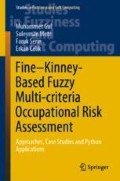Abstract
This chapter proposed an improved Fine–Kinney occupational risk assessment approach using a well-known MCDM method “TOPSIS” under interval type-2 fuzzy set concept. It is defined as a technique for order preference by similarity to ideal solution by Hwang and Yoon [1]. It is based on separation from ideal and anti-ideal solution concept. Since the initial crisp data-based version is insufficient by time in reflecting the uncertainty in decision-maker’s opinions, fuzzy sets are integrated to the TOPSIS algorithm to provide a solid and comprehensive method. Interval type-2 fuzzy set is an improved version of the type-1 fuzzy set. It is also a special version of a general type-2 fuzzy set. Since general type-2 fuzzy systems contain complex computational operations, they cannot be easily applied to real-world problems such as occupational risk assessment. Interval type-2 fuzzy sets are the most frequently used type-2 fuzzy sets due to their ability in handling more uncertainty and producing more accurate and solid results. The Fine–Kinney concept is merged with the interval type-2 fuzzy set concept and TOPSIS for the first time through the literature. To demonstrate the applicability of the proposed approach, a case study is carried out in a chrome plating unit of a gun factory. Some beneficial validation and sensitivity analysis are also performed. Finally, as a creative contribution of our book, the implementation of the proposed approach in Python is performed.
Access this chapter
Tax calculation will be finalised at checkout
Purchases are for personal use only
Notes
- 1.
Reprinted from Ref. [5], Copyright 2014, with permission from Elsevier
References
Hwang, C.L, Yoon, K. (1981). Multiple attribute decision making: Methods and applications, a state of the art survey. Springer, New York.
Mendel, J. M., John, R. I., & Liu, F. (2006). Interval type-2 fuzzy logic systems made simple. IEEE Transactions on Fuzzy Systems, 14(6), 808–821.
Lee, L. W., & Chen, S. M. (2008). Fuzzy multiple attributes group decision-making based on the extension of TOPSIS method and interval type-2 fuzzy sets. In International Conference on Machine Learning and Cybernetics, 2008 (Vol. 6, pp. 3260–3265). IEEE.
Chen, S. M., & Lee, L. W. (2010). Fuzzy multiple attributes group decision-making based on the interval type-2 TOPSIS method. Expert Systems with Applications, 37(4), 2790–2798.
Celik, E., Aydin, N., & Gumus, A. T. (2014). A multiattribute customer satisfaction evaluation approach for rail transit network: A real case study for Istanbul, Turkey. Transport Policy, 36, 283–293.
Celik, E., Bilisik, O. N., Erdogan, M., Gumus, A. T., & Baracli, H. (2013). An integrated novel interval type-2 fuzzy MCDM method to improve customer satisfaction in public transportation for Istanbul. Transportation Research Part E: Logistics and Transportation Review, 58, 28–51.
Celik, E., Gul, M., Aydin, N., Gumus, A. T., & Guneri, A. F. (2015). A comprehensive review of multi criteria decision making approaches based on interval type-2 fuzzy sets. Knowledge-Based Systems, 85, 329–341.
Celik, E., Gumus, A. T., & Erdogan, M. (2016). A new extension of the ELECTRE method based upon interval type-2 fuzzy sets for green logistic service providers evaluation. Journal of Testing and Evaluation, 44(5), 1813–1827.
Soner, O., Celik, E., & Akyuz, E. (2017). Application of AHP and VIKOR methods under interval type 2 fuzzy environment in maritime transportation. Ocean Engineering, 129, 107–116.
Demirel, H., Akyuz, E., Celik, E., & Alarcin, F. (2019). An interval type-2 fuzzy QUALIFLEX approach to measure performance effectiveness of ballast water treatment (BWT) system on-board ship. Ships and Offshore Structures, 14(7), 675–683.
Celik, E., & Gumus, A. T. (2016). An outranking approach based on interval type-2 fuzzy sets to evaluate preparedness and response ability of non-governmental humanitarian relief organizations. Computers & Industrial Engineering, 101, 21–34.
Celik, E., & Gumus, A. T. (2018). An assessment approach for non-governmental organizations in humanitarian relief logistics and an application in Turkey. Technological and Economic Development of Economy, 24(1), 1–26.
Kahraman, C., Öztayşi, B., Sarı, İ. U., & Turanoğlu, E. (2014). Fuzzy analytic hierarchy process with interval type-2 fuzzy sets. Knowledge-Based Systems, 59, 48–57.
Celik, E. (2017). A cause and effect relationship model for location of temporary shelters in disaster operations management. International Journal of Disaster Risk Reduction, 22, 257–268.
Yoon, K. P., & Hwang, C. L. (1995). Multiple attribute decision making: An introduction (Vol. 104). Thousand Oaks, CA, USA, Sage Publications.
Oz, N. E., Mete, S., Serin, F., & Gul, M. (2019). Risk assessment for clearing and grading process of a natural gas pipeline project: An extended TOPSIS model with Pythagorean fuzzy sets for prioritizing hazards. Human and Ecological Risk Assessment: An International Journal, 25(6), 1615–1632.
Gul, M., Guven, B., & Guneri, A. F. (2018). A new Fine-Kinney-based risk assessment framework using FAHP-FVIKOR incorporation. Journal of Loss Prevention in the Process Industries, 53, 3–16.
Author information
Authors and Affiliations
Corresponding author
Rights and permissions
Copyright information
© 2021 Springer Nature Switzerland AG
About this chapter
Cite this chapter
Gul, M., Mete, S., Serin, F., Celik, E. (2021). Fine–Kinney-Based Occupational Risk Assessment Using Interval Type-2 Fuzzy TOPSIS. In: Fine–Kinney-Based Fuzzy Multi-criteria Occupational Risk Assessment. Studies in Fuzziness and Soft Computing, vol 398. Springer, Cham. https://doi.org/10.1007/978-3-030-52148-6_3
Download citation
DOI: https://doi.org/10.1007/978-3-030-52148-6_3
Published:
Publisher Name: Springer, Cham
Print ISBN: 978-3-030-52147-9
Online ISBN: 978-3-030-52148-6
eBook Packages: EngineeringEngineering (R0)

